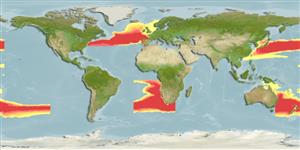>
Ophidiiformes (Cusk eels) >
Bythitidae (Livebearing brotulas)
Etymology: Parabrotula: Greek, para = the side of + Latin, brotula, -ae = little, bud, shoot (Ref. 45335).
Environment: milieu / climate zone / depth range / distribution range
Ecologia
marinhas batipelágico; intervalo de profundidade 0 - 3000 m (Ref. 35509). Deep-water
Northeast Atlantic: most of the known specimens from the area (Ref. 36126). Eastern Atlantic: Gulf of Guinea, one specimen 0°42'S, 7°E (Ref. 10800). Southeast Atlantic: off East London, South Africa. Western Pacific: Japan and Australia (Ref. 11228).
Tamanho / Peso / Idade
Maturity: Lm ? range ? - ? cm
Max length : 5.4 cm SL macho/indeterminado; (Ref. 35509)
Descrição suscinta
Chaves de identificação | Morfologia | Morfometria
Espinhos dorsais (total) : 0; Raios dorsais (total) : 37 - 41; Espinhos anais: 0; Raios anais : 34 - 38. Body long, naked and compressed. Skin loose, thin but not gelatinous. Snout pointed. Gill opening large. Head and body uniformly dark brown in alcohol (Ref. 35852).
Found on the continental slope (Ref. 75154). Viviparous (Ref. 10800). Minimum depth from Ref. 58018.
Ciclo de vida ou comportamento de acasalamento
Maturities | Reprodução | Spawnings | Egg(s) | Fecundities | Larvas
Anderson, M.E., 1986. Parabrotulidae. p. 343. In M.M. Smith and P.C. Heemstra (eds.) Smiths' sea fishes. Springer-Verlag, Berlin. (Ref. 6608)
Status na Lista Vermelha da UICN (Ref. 130435)
Ameaça para os humanos
Harmless
Uso pelos humanos
Ferramentas
Relatórios especiais
Baixar XML
Fontes da internet
Estimates based on models
Preferred temperature (Ref.
123201): 3.7 - 10.6, mean 6 °C (based on 497 cells).
Índice de diversidade filogenética (Ref.
82804): PD
50 = 0.8750 [Uniqueness, from 0.5 = low to 2.0 = high].
Bayesian length-weight: a=0.00102 (0.00046 - 0.00225), b=3.06 (2.88 - 3.24), in cm total length, based on all LWR estimates for this body shape (Ref.
93245).
Nível Trófico (Ref.
69278): 3.2 ±0.5 se; based on size and trophs of closest relatives
Resiliência (Ref.
120179): Baixo, tempo mínimo de duplicação da população 4,5 - 14 anos (Assuming Fec<100).
Fishing Vulnerability (Ref.
59153): Low vulnerability (10 of 100).
